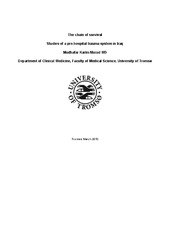The Chain of Survival. Studies of a prehospital trauma system in Iraq
Permanent link
https://hdl.handle.net/10037/5440View/
Thesis introduction (PDF)
Murad KM, Larsen S and Husum H.: 'Prehospital trauma care reduces mortality. Ten-year results from a time-cohort and trauma audit study in Iraq', Scandinavian Journal of Trauma, Resuscitation and Emergency Medicine (2012), 20:13. This is the accepted manuscript version, published version available at http://dx.doi.org/10.1186/1757-7241-20-13 (PDF)
Murad KM and Husum H.: 'Trained lay first responders reduce trauma mortality: A controlled study of rural trauma in Iraq', Prehospital and Disaster Medicine (2010), vol. 25(6):533-539. Also available at http://journals.cambridge.org/action/displayAbstract?fromPage=online&aid=8257143&fulltextType=RA&fileId=S1049023X00008724 (PDF)
Murad KM, Issa DB, Mustafa FM, Hassan HO and Husum H.: 'Prehospital trauma system reduces mortality in severe trauma: a controlled study of road-traffic casualties in Iraq', Prehospital and Disaster Medicine (2012), vol. 27(1):36-41. Also available at http://dx.doi.org/10.1017/S1049023X11006819 (PDF)
Full thesis with articles (PDF)
Date
2013-09-06Type
Doctoral thesisDoktorgradsavhandling
Author
Murad, Mudhafar KarimAbstract
Most trauma deaths in war occur outside hospital, in the mine fields and on the way to hospital. To improve survival, a prehospital trauma system was set up in 1997 by the PhD candidate with trauma experts from UNN in the minefields of North Iraq. The model worked well and reduced death rates from 40% to 10%. The model was further refined and adapted to manage highway traffic casualties, and in 2003 also to support the communities caught in the war zones in Central Iraq. A three-tier rescue system of lay first helpers, trained in-field paramedics, and professional Emergency Room care providers had a significant impact on survival, especially in severely injured patients. The studies document for the first time that trained first helpers at grassroots level improves survival where out-of hospital times are long.
Publisher
University of TromsøUniversitetet i Tromsø
Metadata
Show full item recordCollections
Copyright 2013 The Author(s)
The following license file are associated with this item:


 English
English norsk
norsk
